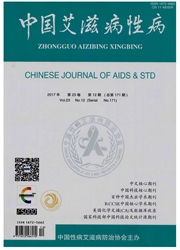

 中文摘要:
中文摘要:
目的探讨Toll样受体4基因(TLR4),在艾滋病病毒(HIV)相关型卡波西肉瘤(KS)肿瘤组织及正常组织中的表达。方法收集2011年5月至2013年7月,在新疆医科大学第一附属医院及新疆传染病医院就诊并经病理明确诊断的患者的KS肿瘤组织,应用实时荧光定量聚合酶链反应(PCR)及免疫组化方法检测TLR4在卡波西肉瘤组织中的表达与分布。结果 TLR4基因在KS肿瘤组织中(病例组包括HIV-KS 26例,经典KS 9例),mRNA表达的水平均低于正常皮肤组织(对照组10例),差异有统计学意义(t=3.368,P=0.0017)。经典KS及正常组织的表达差异有统计学意义(t=2.076,P=0.0497),HIV-KS与正常组织的表达差异有统计学意义(t=3.062,P=0.0054)。而在经典KS及HIV-KS之间表达差异无统计学意义(t=1.230,P=0.46)。免疫组化中,在经典KS及HIV-KS病损皮肤组织真皮层可见TLR4阳性细胞,主要表达于内皮细胞和异形细胞的胞质和胞膜。结论在艾滋病患者中,TLR4低表达与HIV-KS的发生密切相关。
 英文摘要:
英文摘要:
Objective To investigate expression of Toll-like receptor (TLR) 4 mRNA in HIV related kaposi's sarcoma (KS) and normal tissues. Methods KS tissues were collected from patients comfirmly diagnosed as HIV related KS in the first affiliated hospital of Xin Jiang Medical University and Xinjiang Infectious disease hospital from May 2011 to July 2013. Real time PCR and immunohistochemical method were used to detect expression and distribution of TLR4 in KS tissues. Results Expression of TLR4 mRNA in tumor tissues of KS patients (including 26 HIV-KS'and 9 classic KS) was lower than that in normal tissues (t=3. 368, P=0. 0017). Meanwhile, there was significant difference between classic KS and normal tissues (t= 2. 076, P= 0. 0497). Difference between HIV-KS and normal tissues was also significant (t= 3. 062, P=0. 0054). However, no significant difference was observed between the classical KS and HIV KS (t= 1. 230 ,P=0.46). In immunohistochemical staining, TLR4 positive cells could be found in skin dermis of classical KS and HIV-KS tissues, mainly expressed in cytoplasm and cell membrane of endothelial cells and abnormal cells. Conclusion Low expression of TLR4 and development of HIV-KS are close ly related.
 同期刊论文项目
同期刊论文项目
 同项目期刊论文
同项目期刊论文
 期刊信息
期刊信息
